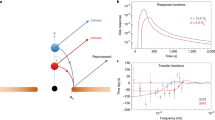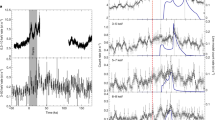Abstract
Accretion onto black holes is key to their growth over cosmic time1, especially during the active galactic nuclei phase when the inflowing material forms a radiatively efficient accretion disk2. To probe the disk, indirect imaging methods such as reverberation mapping3,4,5,6 and microlensing7,8 are required. Recent findings suggest that the disk may be larger than theoretical predictions by a factor of a few4,6,9, thus casting doubt on our understanding of accretion in the general astrophysical context. Whether new physics is implied10,11,12 or poorly understood biases are in effect5,6,13,14 is a longstanding question. Here, we report new reverberation data based on a unique narrowband-imaging design15, and argue that time delays between adjacent optical bands are primarily associated with the reprocessing of light by a farther away under-appreciated non-disk component. This component is associated with high-density photoionized material that is uplifted from the outer accretion disk, probably by radiation-pressure force on dust, and thus may represent the long-sought origin of the broad-line region16. Our findings suggest that the optical phenomenology of some active galactic nuclei may be substantially affected by non-disk continuum emission with implications for measuring the fundamental properties of black holes and their active environs over cosmic time.
This is a preview of subscription content, access via your institution
Access options
Access Nature and 54 other Nature Portfolio journals
Get Nature+, our best-value online-access subscription
$29.99 / 30 days
cancel any time
Subscribe to this journal
Receive 12 digital issues and online access to articles
$119.00 per year
only $9.92 per issue
Buy this article
- Purchase on Springer Link
- Instant access to full article PDF
Prices may be subject to local taxes which are calculated during checkout




Similar content being viewed by others
Data availability
The data that support the plots within this paper and other findings of this study are available from the corresponding author upon reasonable request.
References
Yu, Q. & Tremaine, S. Observational constraints on growth of massive black holes. Mon. Not. R. Astron. Soc. 335, 965–976 (2002).
Shakura, N. I. & Sunyaev, R. A. Black holes in binary systems. Observational appearance. Astron. Astrophys. 24, 337–355 (1973).
Collier, S. J. et al. Steps toward determination of the size and structure of the broad-line region in active galactic nuclei. XIV. Intensive optical spectrophotometric observations of NGC 7469. Astrophys. J. 500, 162–172 (1998).
Fausnaugh, M. M. et al. Space telescope and optical reverberation mapping project. III. Optical continuum emission and broadband time delays in NGC 5548. Astrophys. J. 821, 56 (2016).
Edelson, R. et al. Space telescope and optical reverberation mapping project. II. Swift and HST reverberation mapping of the accretion disk of NGC 5548. Astrophys. J. 806, 129 (2015).
Cackett, E. M. et al. Accretion disk reverberation with Hubble Space Telescope observations of NGC 4593: evidence for diffuse continuum lags. Astrophys. J. 857, 53 (2018).
Blackburne, J. A., Pooley, D., Rappaport, S. & Schechter, P. L. Sizes and temperature profiles of quasar accretion disks from chromatic microlensing. Astrophys. J. 729, 34 (2011).
Jiménez-Vicente, J. et al. The average size and temperature profile of quasar accretion disks. Astrophys. J. 783, 47 (2014).
Morgan, C. W., Kochanek, C. S., Morgan, N. D. & Falco, E. E. The quasar accretion disk size—black hole mass relation. Astrophys. J. 712, 1129–1136 (2010).
Dexter, J. & Agol, E. Quasar accretion disks are strongly inhomogeneous. Astrophys. J. Lett. 727, L24 (2011).
Gardner, E. & Done, C. The origin of the UV/optical lags in NGC 5548. Mon. Not. R. Astron. Soc. 470, 3591–3605 (2017).
Hall, P. B., Sarrouh, G. T. & Horne, K. Non-blackbody disks can help explain inferred AGN accretion disk sizes. Astrophys. J. 854, 93 (2018).
Korista, K T. & Goad, M. R. The variable diffuse continuum emission of broad-line clouds. Astrophys. J. 553, 695–708 (2001).
McHardy, I. et al. X-ray/UV/optical variability of NGC 4593 with swift: reprocessing of X-rays by an extended reprocessor. Mon. Not. R. Astron. Soc. 480, 2881 (2018).
Pozo Nuñez, F., Chelouche, D., Kaspi, S. & Niv, S. Automatized photometric monitoring of active galactic nuclei with the 46 cm telescope of the wise observatory. Publ. Astron. Soc. Pac. 129, 094101 (2017).
Czerny, B. & Hryniewicz, K. The origin of the broad line region in active galactic nuclei. Astron. Astrophys. 525, L8 (2011).
Chelouche, D. The case for standard irradiated accretion disks in active galactic nuclei. Astrophys. J. 772, 9 (2013).
Gaskell, C. M. The case for cases B and C: intrinsic hydrogen line ratios of the broad-line region of active galactic nuclei, reddenings, and accretion disc sizes. Mon. Not. R. Astron. Soc. 467, 226–238 (2017).
Pancoast, A. et al. Modelling reverberation mapping data—II. Dynamical modelling of the lick AGN monitoring project 2008 data set. Mon. Not. R. Astron. Soc. 445, 3073–3091 (2014).
Santos-Lleó, M. et al. Monitoring of the optical and 2.5–11.7 μm spectrum and mid-IR imaging of the Seyfert 1 galaxy Mrk 279 with ISO. Astron. Astrophys. 369, 57–64 (2001).
Phinney, E. S. Dusty disks and the infrared emission from AGN. NATO ASI C 290, 457 (1989).
Sirko, E. & Goodman, J. Spectral energy distributions of marginally self-gravitating quasi-stellar object discs. Mon. Not. R. Astron. Soc. 341, 501–508 (2003).
Bentz, M. & Katz, S. The AGN black hole mass database. Publ. Astron. Soc. Pac. 127, 67 (2015).
Laor, A. & Davis, S. W. Cold accretion discs and lineless quasars. Mon. Not. R. Astron. Soc. 417, 681–688 (2011).
Baskin, A., Laor, A. & Stern, J. Radiation pressure confinement—II. Application to the broad-line region in active galactic nuclei. Mon. Not. R. Astron. Soc. 438, 604–619 (2014).
Ferland, G. J. et al. The 2017 release CLOUDY. Rev. Mex. Astron. Astr. 53, 385–438 (2017).
Czerny, B. et al. Failed radiatively accelerated dusty outflow model of the broad line region in active galactic nuclei. I. Analytical solution. Astrophys. J. 846, 154 (2017).
Bentz, M. C. et al. The low-luminosity end of the radius–luminosity relationship for active galactic nuclei. Astrophys. J. 767, 149 (2013).
Davis, S. W. & Laor, A. The radiative efficiency of accretion flows in individual active galactic nuclei. Astrophys. J. 728, 98 (2011).
Netzer, H. Revisiting the unified model of active galactic nuclei. Annu. Rev. Astron. Astrophys. 53, 365–408 (2015).
Bertin, E. & Arnouts, S. SExtractor: software for source extraction. Astron. Astrophys. Suppl. 117, 393–404 (1996).
Bertin, E. et al. The TERAPIX pipeline. In Astronomical Data Analysis Software and Systems XI (eds Bohlender, D. A., Durand, D. & Handley, T. H.) 228 (Conference Series Volume 281, Astronomical Society of the Pacific, 2002).
Chelouche, D., Pozo-Nuñez, F. & Zucker, S. Methods of reverberation mapping. I. Time-lag determination by measures of randomness. Astrophys. J. 844, 146 (2017).
Peterson, B. M. et al. On uncertainties in cross-correlation lags and the reality of wavelength-dependent continuum lags in active galactic nuclei. Publ. Astron. Soc. Pac. 110, 660–670 (1998).
Schlafly, E. F. & Finkbeiner, D. P. Measuring reddening with Sloan Digital Sky Survey stellar spectra and recalibrating SFD. Astrophys. J. 737, 103 (2011).
Choloniewski, J. The shape and variability of the nonthermal component of the optical spectra of active galaxies. Acta Astronom. 31, 293 (1981).
Winkler, H. et al. Variability studies of Seyfert galaxies. I—broad-band optical photometry. Mon. Not. R. Astron. Soc. 257, 659–676 (1992).
Pozo Nuñez, F. et al. Photometric reverberation mapping of 3C 120. Astron. Astrophys. 545, A84 (2012).
Sakata, Y. et al. Long-term optical continuum color variability of nearby active galactic nuclei. Astrophys. J. 711, 461–483 (2010).
Kinney, A. et al. Template ultraviolet to near-infrared spectra of star-forming galaxies and their application to K-corrections. Astrophys. J. 467, 38 (1996).
Pogge, R. & Martini, P. Hubble Space Telescope imaging of the circumnuclear environments of the CfA Seyfert galaxies: nuclear spirals and fueling. Astrophys. J. 569, 624–640 (2002).
Peterson, B. M. Reverberation mapping of active galactic nuclei. Publ. Astron. Soc. Pac. 105, 247–268 (1993).
Alexander, T. Improved AGN light curve analysis with the z-transformed discrete correlation function. Preprint at https://arxiv.org/abs/1302.1508 (2013).
Rybicki, G. B. & Press, W. H. Interpolation, realization, and reconstruction of noisy, irregularly sampled data. Astrophys. J. 398, 169–176 (1992).
Zu, Y., Kochanek, C. S. & Peterson, B. M. An alternative approach to measuring reverberation lags in active galactic nuclei. Astrophys. J. 735, 80 (2011).
Li, Y.-R., Wang, J.-M. & Bai, J.-M. A non-parametric approach to constrain the transfer function in reverberation mapping. Astrophys. J. 831, 206 (2016).
Chelouche, D. & Zucker, S. Quasar cartography: from black hole to broad-line region scales. Astrophys. J. 769, 124 (2013).
Pijpers, F. P. & Wanders, I. Reverberation mapping of active galactic nuclei: the SOLA method for time-series inversion. Mon. Not. R. Astron. Soc. 271, 183–196 (1994).
Welsh, W. F. On the reliability of cross-correlation function lag determinations in active galactic nuclei. Publ. Astron. Soc. Pac. 111, 1347–1366 (1999).
Scott, J. E. et al. Variable intrinsic absorption in Mrk 279. Astrophys. J. 694, 438–448 (2009).
Stevans, M. L., Shull, J. M., Danforth, C. W. & Tilton, E. M. HST-COS observations of AGNs. II. Extended survey of ultraviolet composite spectra from 159 active galactic nuclei. Astrophys. J. 794, 75 (2014).
Mehdipour, M. et al. Multi-wavelength campaign on NGC 7469. III. Spectral energy distribution and the AGN wind photoionisation modelling, plus detection of diffuse X-rays from the starburst with Chandra HETGS. Astron. Astrophys. 615, A72 (2018).
Warner, C., Hamann, F. & Dietrich, M. A relation between supermassive black hole mass and quasar metallicity?. Astrophys. J. 596, 72–84 (2003).
Dietrich, M. et al. Continuum and emission-line strength relations for a large active galactic nuclei sample. Astrophys. J. 581, 912–912 (2002).
Maoz, D. et al. High-rate spectroscopic active galactic nucleus monitoring at the Wise Observatory. I—Markarian 279. Astrophys. J. 351, 75–82 (1990).
Stern, J. & Laor, A. Type 1 AGN at low z. I. Emission properties. J. Phys. Conf. Ser. 423, 600–631 (2012).
Baldwin, J., Ferland, G., Korista, K. & Verner, D. Locally optimally emitting clouds and the origin of quasar emission lines. Astrophys. J. Lett. 455, L119 (1995).
Acknowledgements
We thank D. Maoz for continuous support of the project at the Wise Observatory, and S. Niv for enabling the robotic use of the C18 telescope. This work was partly supported by grants 950/15 from the Israeli Science Foundation and 3555/14-1 from the Deutsche Forschungsgemeinschaft. Computations on the Hive computer cluster at the University of Haifa are partly supported by Israeli Science Foundation grant 2155/15.
Author information
Authors and Affiliations
Contributions
D.C. conceived the project, post-processed the light curves, carried out time-series analyses and photoionization calculations, and wrote the paper. F.P.N. acquired the data, reduced them, carried out flux variation gradient calculations and time-series analyses, and contributed to writing the paper. S.K. assisted with the data reduction and time-series analyses, and provided technical support of telescope operations.
Corresponding authors
Ethics declarations
Competing interests
The authors declare no competing interests.
Additional information
Publisher’s note: Springer Nature remains neutral with regard to jurisdictional claims in published maps and institutional affiliations.
Supplementary information
Supplementary Information
Supplementary Figures 1–10, Supplementary Tables 1–2, Supplementary References 1–3
Rights and permissions
About this article
Cite this article
Chelouche, D., Pozo Nuñez, F. & Kaspi, S. Direct evidence of non-disk optical continuum emission around an active black hole. Nat Astron 3, 251–257 (2019). https://doi.org/10.1038/s41550-018-0659-x
Received:
Accepted:
Published:
Issue Date:
DOI: https://doi.org/10.1038/s41550-018-0659-x
This article is cited by
-
Science with a Small Two-Band UV-Photometry Mission III: Active Galactic Nuclei and Nuclear Transients
Space Science Reviews (2024)
-
Accretion disks, quasars and cosmology: meandering towards understanding
Astrophysics and Space Science (2023)



